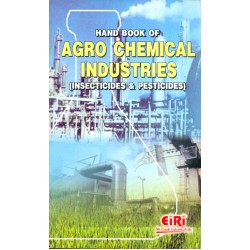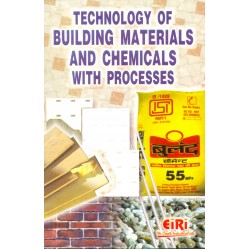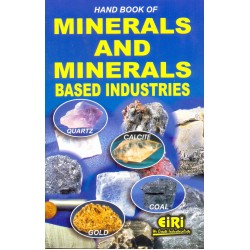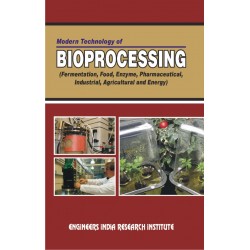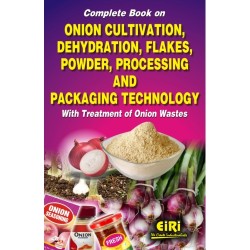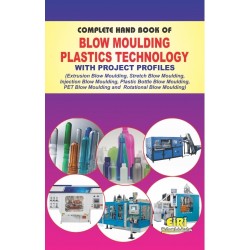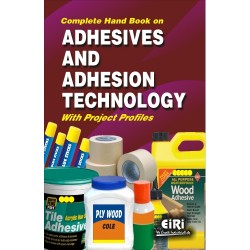Complete Technology Book on Identification of Plastics and Plastic Products Materials (Additives, Applications, Biodegradation, Biomedical, Bulk Moulding Compound, Chemical Analysis, XLPE, Drip Irrigation, Expanded Polyethylene, Polystyrene & HDPE)

- More than 45 years of experience
- Managed by expert industrial consultants
- ISO 9001-2015 Certified
- Registered under MSME, UAM No: DL01E0012000
- 24/5 Research Support
Get your quesries resolved from an industry expert. Ask your queries before report or book purchase. - Custom Research Service
Speak to the our consultant to design an exclusive study to serve your research needs. - Quality Assurance
All reports are prepared by highly qualified consultants & verified by a panel of experts. - Information Security
Your personal & confidential information is safe & secure.
The book covers Identification of Plastics, Additives for Polyolefins, Various Plastics Applications, Biodegradation of Plastics and Polymers, Biomedical Applications of Polymers and Plastics, Bulk Moulding Compounds (BMC), Chemical Analysis of Plastics and Polymers, Chemical Analysis of Additives in Plastics and polymers, Cross Linked Polyethylene Compound, Drip Irrigation, Biodegradable Polymer Systems, Electrically Conducting Polymers, Expanded Polyethylene, Expanded Polystyrene, HDPE Tarpaulins as Sacks for Fruits & Vegetables, High Density Polyethylene (HDPE).
Product Description
IDENTIFICATION OF PLASTICS
Beginning
Inhouse identification facilities
Laboratory
Equipments to be used
Glasswares and other Accessories
Optional accessories
Chemicals
Solvents
Organic reagents
Inorganic chemicals
Acids and bases
Miscellaneous
Identification of Plastics (Simple Methods)
Physical Identification
Visual appearance
Method of fabrication
Penetration to hot rod and cutting with a knife
Floatation test
Colour
Odour
Burning test
Bending test
Film tear test
Chemical Identification
Pyrolysis test
Solubility test
Softening and melting points
Detection of elements
Preparation of sodium fusion extract
Nitrogen
Chlorine and Bromine
Fluorine
Sulphur
Detection of phosphorus
Preparation of ammonium molybdate solution
Confirmation tests
Tests for Polyolefins
Test for Chlorine Containing Polymers
Test for Caprolactum in Nylon 6
Test for Adipic acid in Nylon 6.6
Test for Polycarbonate
Test for PMMA
Test for Polyacetals
Tests for PET and PBT
Test for Polyurethane
Test for Cellulose in Cellulosics (Molisch Reaction)
Test for acetates and propionates
Test for cellulose ethers
Detection of methyl cellulose
Reaction to heating and burning
Detection of ethyl cellulose
Tests for phenol formaldehyde (PF), urea formaldehyde (UF) and melamine formaldehyde (MF)
Test for epoxy resin
Foucry test
Test for alkyd resins
Test for phthalate
Identification of plastics materials
Thermoplastics
ABS
Acetal
Acrylic
Cellulose acetate
Cellulose acetate butyrate
Cellulose propionate
Fluorocarbons (FEP,CTFE, PTFE, PVF)
Nylons
Polycarbonate
Thermoplastic polyester
PVC
Polyethylene
Polypropylene
Polystyrene
Polyphenylene oxide (PPO)
Polysulphone
Polyurethane (Thermoplastic)
Thermosetting Plastics
Diallyphthalate (DAP)
Epoxy
Phenol formaldehyde
Urea formaldehyde
Melamine formaldehyde
Polyesters
Silicones
Identification of plastics (instrumental methods)Infrared Spectroscopy
Sample preparation
Capillary films
Solutions
Films
Pellets
Mulls
Identification
Monomer content studies
Crystallisation of polymers
Compatibility of polymers
Copolymer composition analysis
Polymer degradation
Thermal Analysis
Differential scanning calorimetry
Thermogravimetric analyser
Pyrolysis Gas Chromatography
Applications
Nuclear Magnetic Resonance Spectroscopy (NMR)
Applications of NMR to polymers
ADDITIVES FOR POLYOLEFINS
Introduction
Types of Additives
Incorporation of Additives
Antioxidants
Types
U.V.Stabilizers
Antiblocking agents
Slip agents
Antistatic agents
Metal deactivators
Colourants
Nucleating Agents
Crosslinking
Flame retardants
Fillers and reinforcing agents
Impact modifiers
Blowing agents
Cling agents
Lubricants & processing aids
masterbatches
VARIOUS PLASTICS APPLICATIONS
Introduction
Plastics for space application
Materials for space
Materials for structural and related applications
Thermal control Materials
Materials for lubricated system
Electronic Components Materials
Materials for adhesion/sealing etc.
Adhesives
Sealant
Plastics Engineering in automobiles
Safety and Economy in Automobiles
Engineering Plastics in Electronics
Properties
Modification of Engineering Plastics
Application in Electronics Industry
Engineering Plastics vs Metals
Capacitors
Plastic Encapsulation of Semi Conductors
Covers and Enclosures
Mechanical and Electrical Parts
Printed Circuit Boards (PCB)
Newer Plastics
High temperature PES
Polyether ether ketone (PEEK)
Engineering Thermoplastics for Mechanical Engineering Applications
Nylon Polyamide
Excellent mechanical load bearing capacity
Favourable friction and abrasion properties
Self lubrication
Vibration and sound damping
Applications in mechanical components
Thermoplastic Polyester
Specific properties
Typical applications in mechanical engineering Polyacetal (POM)
Applications
Polytetrafluoroethylene (PTFE)
Properties
Applications
Ultra High Molecular Weight Polyethylene (UHMWPE)
Properties
Applications
Thermoplastic Polyurethanes
Applications
Polyethylene terephathalate and polybutylene terephthalate in engineering applications
Properties
Processing
Sensitivity to hydrolytic degradation
Low melt viscosity
Precise temperature control
Mould heating
Applications
Electrical
Electronics
Automotives
Domestic applications
Lamps
Mechanical
Building
Plastics in buildings
Plastic Materials
Construction aids
Wall panel
Thermal insulation
Sealants
Adhesives in buildings
Advantages and Disadvantages
Advantages
Disadvantages
Applications of recycled plastics
Recycled LDPE
Recycled PVC
Recycled Polystyrene (PS)
Domestic
Recycled Polyethylene Tetrephthalate (PET)
Recycled Commingied Plastics Waste
BIODEGRADATION OF PLASTICS AND POLYMERS
Mechanisms of degradation in polymers
Photodegradation
Thermal degradation
Chemical degradation
Biological degradation
Factors affecting biodegradability
Effect of Polymer structure, chemical composition and properties
Effect of Environmental factors
Soil texture and structure
Soil temperature
Cation exchange capacity
Soil organic matter (SOM)
Water
Soil pH
BIOMEDICAL APPLICATIONS OF POLYMERS AND PLASTICS
Classification of Biopolymers
Polyester
Polycaprolactone
Poly(b-hydroxybutyrate)
Poly(phosphoesters)
Polycarbonates
Poly(amides)
Polyphosphazenes
Poly(orthoesters)
Polyanhydrides
Factor Affecting Biodegradation
Effect of Polymer Structures
Effect of Polymer Morphology
Effect of Molecular Weight
Effect of Radiation and Chemical Treatment
Biomedical Applications
Surgical Sutures
Bone Fixation Devices
BULK MOULDING COMPOUNDS (BMC)
Overview
Bulk Moulding Compounds
What are bulk Moulding Compounds
Characteristics of Bulk Moulding Compounds
Thermal stability
Flame Retardance
Electrical Properties
Colours
Resistance to Chemicals and Stains
Cost
Storage and Shelf life
Processability
Recyclability
Conclusion
Common uses of BMC in automotive industry
CHEMICAL ANALYSIS OF PLASTICS AND POLYMERS
Introduction
Preparation for Analysis
Preliminary examination
Nitrogen
Chlorine
Sulphur
Phosphorus
Saponification Number
Phenols
Methyl Alcohol
Ethyl Alcohol
Phthalic Acid
Colophony Resins
Other Resins
Nitro groups
Aidehydes
Furfural
Coumarone
Aniline
Glycerol
Carbohydrate (Cellulose)
Acetic Acid
Quantitative analysis
Cellulose Ethers
Methylcellulose
Ethylcellulose
Benzylcellulose
Cellulose Esters
Cellulose acetate
Cellulose acetobutyrate
Nitrocellulose
Polyvinyl Esters
Polyvinyl acetate
Polyvinyl chloride
Polyvinyl chloride acetate
Polystyrene
Polymethacrylic and Polyacrylic Esters
Phenol formaldehyde Condensation Products
Aminoplastis
Proteinoplasts
Aniline formaldehyde
Urea resins
Melamine formaldehyde resin
Thiourea resin
Sulphonemide formaldehyde resins
Nylon
Analysis of aminoplasts
Chlorinated Plastics
Chlorinated rubber
Chlorinated diphenyl
Chlorinated naphthalene
Chloroprene
Natural and synthetic rubber
Plasticizers
CHEMICAL ANALYSIS OF ADDITIVES IN PLASTICS AND POLYMERS
Beginning
Direct spectroscopy of polymer films
Apparatus
Procedure
Preparation of sample film
Recording the infrared spectrum
Measurement of Absorbance
Calibration
Preliminary solvent extraction
Solvent Extraction Procedures
Determination of tinuvin 326 in polypropylene
Apparatus
Reagents
Procedure
Calibration
Polymer Extraction
Determination of phenolic antioxidants
Determination of amine antioxidants
Apparatus
Reagents
Methanol hydrochloric acid solvent
Procedure “A”
Alternate Procedure “B” for PBNA
Determination of plasticizers
Extraction with Single Solvents
Extraction with Mixed Solvents
Multiple Extractions
Improvement of Extractions
Determination of ultra violet absorbers
Method
Apparatus
Reagents
Calibration
Cetting up the fluorimeter
Console controls
Dynode supply
Filter
Recorder
Analysis of Polystyrene
Calculations
Determination of Polygard
Determination of organic peroxides
Determination of p-tert butyl Perbenzoate in Polystyrene
Apparatus
Reagents
Procedure
Calculations
Valuation of styrene, acrylonitrile and methacrylonitrile monomers
Direct Ultra violet Spectroscopic Method for Styrene
Distillation/Ultra violet Spectroscopic Method for Styrene
Polarographic Method for Acrylonitrile
Apparatus
Reagents
Acrylonitrile and styrene monomers Re-distill the monomers immediately before use
Hydrogen or nitrogen extremely low oxygen content
Procedure
CROSS LINKED POLYETHYLENE COMPOUND
Introduction
Plant & Machinery
Radiation crosslinking
Compounding
Applications of radiation crosslinking
Preference of XLPE in cables
Uses of radiation crosslinked polyethylene
Formulations & Processing parameters
DRIP IRRIGATION
What is Drip Irrigation?
Typical setup of Drip Irrigation System
Why Drip Irrigation?
Gvernment Initiative for Popularisation of Irrigation System
Micro Irrigation Scheme
Indian Business
RR+DRTS Together
Important Features of Drip Line Pipe Plant Supplied by R.R.
Drip Emitters DRTS PC Dripper
Why pressure compensating (PC) drippers?
Advantages in slopes
Precision
Lower project cost
Simple Design
Fertilizer advantages
BIODEGRADABLE POLYMER SYSTEMS
Introduction
New tissues using function cells and bio degradable polymer scafffolds
Polymers serve severa Ipurposes
Effective as scaffolds for cell delivery in the generation of new tissue
Some disadvantages of these polymers
Poly (glycolic acid), PGA and poly (lactic acid), PLA and their copolymers
Medical application of PGA
Concerns about degradation
Cross linkable PPF, poly (propylene fumarate)
Polyanhydrides
Polyanhydride for drug delivery applications
Photo cross linkable polyanhydride
Poly carbonates
Polyphosphazene
Poly orthoesters
Polyurethanes
Development of injectable and biodegradable polymer for tissue engineering
Requirements in orthopedic tissue engineering
ELECTRICALLY CONDUCTING POLYMERS
Introduction
Structural features
The band theory of solids and the electrical conductivity of p-conjugated polymers
Doping of organic conjugated polymers
General methods of preparationof conducting polymers
Chemical routes
Electrochemical synthesis
Photochemical synthesis
Attempts to improve the processability of conducting polymers
Electrically conducting polyaniline
Chemical synthesis of emeraldine base
Electrochemical synthesis of polyaniline
Earlier doping studies on polyaniline
Use of Polymer functionalized dopants
Influence of organic sulphonic acids
Polyanilline camphor sulphonic acid/dodpcyl benzene sulphonic acid systems
Secondary doping in polyaniline
Organic phosphonic acids as the dopants
Naturally available organic compound as dopants
Applications of conducting polymers
Conducting plastics in devices
Coaxial cable
Electromagnetic shielding
Thin film trqansistors
Flexible display
Smart windows
Solder
Batteries
Artificial muscle
Biological Sensors
Camouflage coatings
Electroluminescence Lightemitting diode (LED)
Electrostatic materials
Conducting adhesives
Printed circuit boards
Aircraft structures
Molecular electronics
Electrochemical actators
Smart structures
EXPANDED POLYETHYLENE
Beginning
Process
Raw materials
Blowing Agents
Chemical Blowing Agents (CBA)
Physical blowing agents (PBA)
CFC
Butane
Other additives
Open and closed cell foamed plastics
Non-crossedlinked foam
Crosslinked foam
Mouldable Foam beads
properties
Antistatic property
Fire retardant property
Density
Size of cells
Thermal conductivity
Temperature range
Fabrication versatility
Laminate products
Applications
Cushion packaging
Automotive use
Shoes/sports gods
Carpet underlay
Construction
Conclusion
EXPANDED POLYSTYRENE
Introduction
Manufacturing process
Diffusion of blowing agent into Polystyrene
The Quenched Pellet Process
Extrusion process
Processing temperature
Effect of cell nucleating agent
General processing parameters of polystyrene
Some Properties of Polystyrene
properties are to be measured (After foaming)
Applications
HDPE TARPAULINS AS SACKS FOR FRUITS & VEGETABLES
Introduction
11th Plant aimed at doubleing the annual growth rate in the agriculture sector to 4 percent
Growth
Plastics in Agribusiness
Tarpaulin
Advantages of HDPE Tarpaulin
Polyethylene Tarpaulins
Manufacturing Process
Lamination
Sealing
Border making
Machinery
Transportation
Storage
Plastics for Entrepreneurs
HDPE Eyeleted Tarpaulins as sacks for packaging of fruits & vegetales with more number of eyelets for breathability
End Uses of HDPE Tarpaulin
End Uses of HDPE Tarpaulin
HIGH DENSITY POLYTHYLENE (HDPE)
Co-ordination Polymerization (Ziegler Process)
Mechanism
Initiation
Propagation
How to Make Project Report?
Detailed Project Report (DPR) includes Present Market Position and Expected Future Demand, Technology, Manufacturing Process, Investment Opportunity, Plant Economics and Project Financials. comprehensive analysis from industry covering detailed reporting and evaluates the position of the industry by providing insights to the SWOT analysis of the industry.
Each report include Plant Capacity, requirement of Land & Building, Plant & Machinery, Flow Sheet Diagram, Raw Materials detail with suppliers list, Total Capital Investment along with detailed calculation on Rate of Return, Break-Even Analysis and Profitability Analysis. The report also provides a birds eye view of the global industry with details on projected market size and then progresses to evaluate the industry in detail.
We can prepare detailed project report on any industry as per your requirement.
We can also modify the project capacity and project cost as per your requirement. If you are planning to start a business, contact us today.
Detailed Project Report (DPR) gives you access to decisive data such as:
- Market growth drivers
- Factors limiting market growth
- Current market trends
- Market structure
- Key highlights
Overview of key market forces propelling and restraining market growth:
- Up-to-date analyses of market trends and technological improvements
- Pin-point analyses of market competition dynamics to offer you a competitive edge major competitors
- An array of graphics, BEP analysis of major industry segments
- Detailed analyses of industry trends
- A well-defined technological growth with an impact-analysis
- A clear understanding of the competitive landscape and key product segments
Need Customized Project Report?
- Ask for FREE project related details with our consultant/industry expert.
- Share your specific research requirements for customized project report.
- Request for due diligence and consumer centric studies.
- Still haven't found what you're looking for? Speak to our Custom Research Team
About Engineers India Research Institute:
Note: We can also prepare project report on any subject based on your requirement and country. If you need, we can modify the project capacity and project cost based on your requirement.
Our Clients

Our Approach
- Our research reports comprehensively cover Indian markets (can be modified as per your country), present investigation, standpoint and gauge for a time of five years*.
- The market conjectures are produced on the premise of optional research and are cross-accepted through associations with the business players
- We use dependable wellsprings of data and databases. What's more, data from such sources is handled by us and incorporated into the report
Why buy EIRI reports?
- Our project reports include detailed analysis that help to get industry Present Market Position and Expected Future Demand.
- Offer real analysis driving variables for the business and most recent business sector patterns in the business
- This report comprehends the present status of the business by clarifying a complete SWOT examination and investigation of the interest supply circumstance
- Report gives investigation and top to bottom money related correlation of real players/competitors
- The report gives gauges of key parameters which foresees the business execution
























